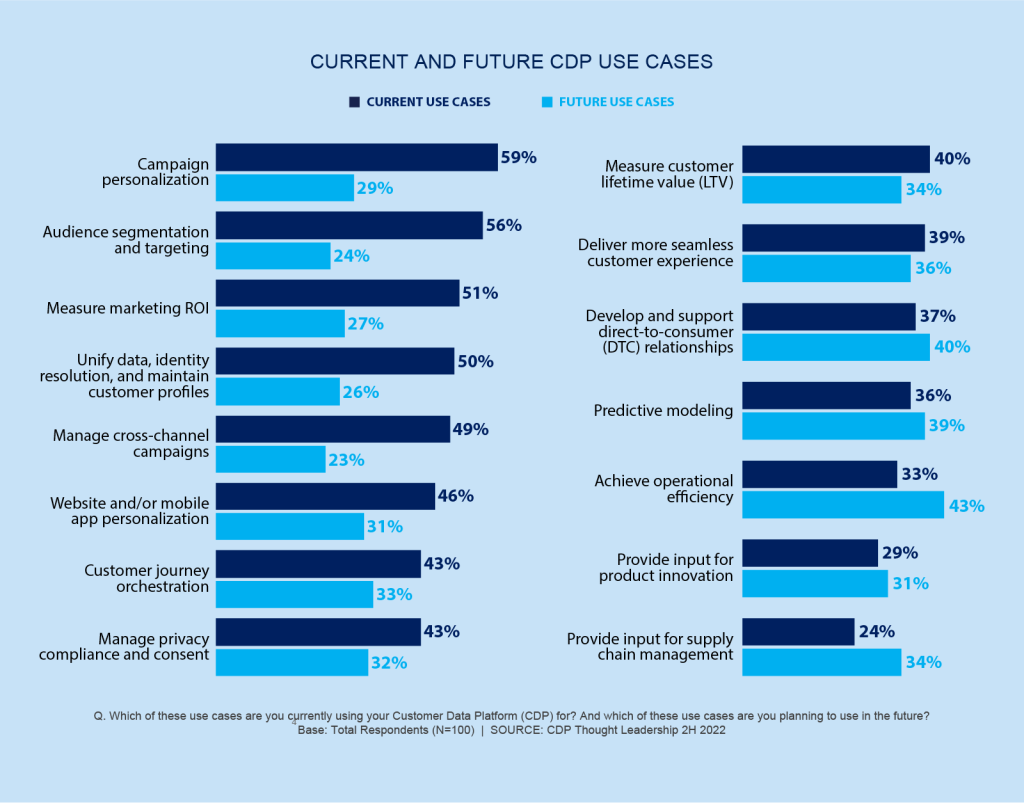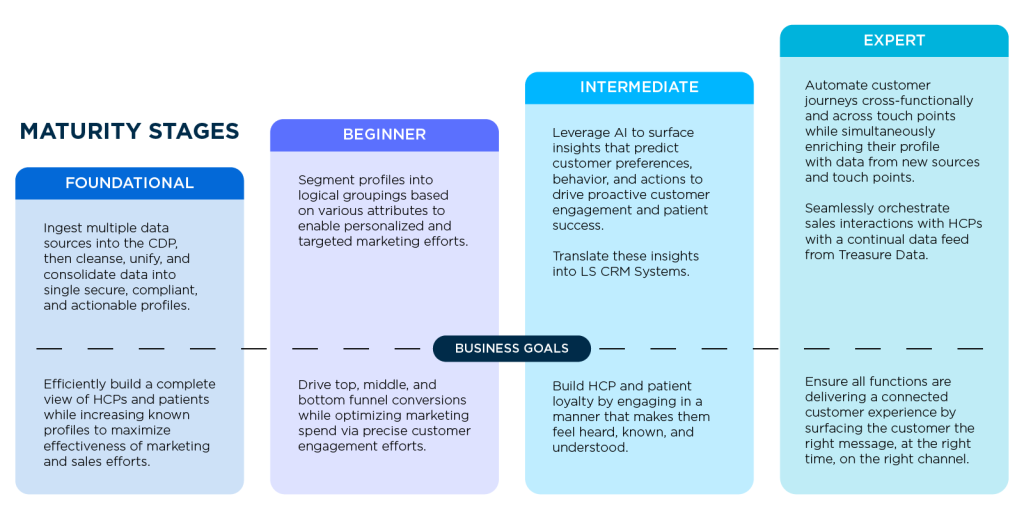Scaling CDP Use Cases With a Customer Data Maturity Model

Whether you are just beginning your data journey, or gaining momentum in making data-based decisions, applying a customer data maturity model can help you identify where you’re getting the most from your data and strategies, and how to improve your processes and data insights.
What is Customer Data Maturity?
Customer data maturity is defined as the extent to which an organization is maximizing the use of their customer data. The ultimate goal is to incorporate customer data into all of your decision making and practices. In the process, your customer data transforms from scattered insights, to a source of information that serves as a driver for decision making.
How Does a Customer Data Maturity Model Help Define CDP Use Cases?
Using a maturity model to measure the sophistication of your customer data management operations can help you identify goals, challenges, and prescriptive actions to take as you prioritize CDP use cases and build your CDP roadmap.
These goals and prescriptive actions allow you to focus on gaining valuable results strategically by focusing on both short-term wins, and long-term gains at scale. As the saying goes–you can’t run until you can walk. The same goes for digital transformation.
For example, before you can take on more complicated CDP use cases, or layer on additional capabilities–like artificial intelligence (AI), machine learning (ML) and predictive analytics, you must first have the foundational pieces of data management in place. Focusing on the right CDP use cases at the right times gives you the opportunity to see more immediate time to value, while setting your organization up for long-term success.
With the right planning, seeing value from your CDP investment can be pretty swift. According to research from Treasure Data and Advertiser Perceptions, a majority of organizations that adopt a CDP begin to see value in eight months, on average.
Business leaders also recognize the future value that CDPs can bring as their organization continues to increase data maturity, and introduces more complex CDP use cases across the organization. According to the report (see Figure 1), these future gains are especially notable when it comes to applying AI and ML, improved marketing and IT efficiency, and the ability to build and optimize their first-party data strategy.

Figure 1. Current and Future CDP Use Cases, Advertiser Perceptions.
The Stages of Data Maturity
At Treasure Data, we have developed a customer data maturity model (Figure 2) that can help you understand where your organization is when using customer data to make key decisions. This model will also help you identify how to prioritize the right CDP use cases based on your level of data maturity, and how to use your data to create a competitive edge for your business in a way that’s scalable and secure.

Figure 2. Data Maturity Model
Customer Data Maturity Stage 1: Foundational
At this stage, focus revolves around centralizing and integrating first, second and third-party data sources into your CDP to establish a data foundation. Making sense of your data helps you understand your customer base, identify your ratio of known to unknown records, and establish company-wide data privacy and governance practices.
Part of this process includes cleansing and de-duping inaccurate records to create a unified customer profile. AI-powered identity resolution can then be applied to enrich data and increase the number of known profiles in your database. Data privacy, consent management, and governance safeguards are also applied to ensure that data is managed securely and in compliance with global data privacy regulations.
How you choose to prioritize and ingest data into your CDP can also be guided by the business outcomes you want to achieve.
“Don’t try and do it all at once, and grab all your data from everywhere and push it into the CDP,” Kim Davis, editorial director, MarTech, told CDP.com. “Be guided by the use cases you’re planning to undertake, which will help prioritize the data to focus on.”
Ultimately, unifying data from across sources and systems is fundamental for establishing a data foundation across what could sometimes be a complex network of global brands.
For example, with Treasure Data, AB InBev was able to connect 757 global systems and 70 million unique customer records across 500 brands in less than six months. This brought data that was once siloed across brands, or held by agency partners, together into unified customer profiles that were made accessible across teams. This foundation allowed AB InBev to optimize how they worked—from increasing operational efficiency, to improving marketing and ad campaigns across brands.
Customer Data Maturity Stage 2: Beginner
With a good foundation in place, you can now begin to use your customer data to maximize marketing, sales, service, and operational efficiency. CDP use cases at this stage include optimizing ad spend through audience segmentation, improving conversion, reducing churn, and personalizing experiences for both known and unknown audiences. These use cases set the framework for establishing the personalization needed to improve conversion and build customer loyalty.
For example, Stripe, a retail and lifestyle brand, was able to segment specific audiences to perform lookalike analysis and identify new prospects for its brands. They also applied predictive retention and scoring models to determine which customers are most likely to buy or churn, and modeled customer behavior to measure and optimize campaign performance. These efforts increased revenue attainment by 70 percentage points in only three months.
Customer Data Maturity Stage 3: Intermediate
At this stage, you can now start to do even more with your data. Advanced analytics, AI capabilities that power real-time personalization use cases, and next-best action recommendations can take you one step closer to fully orchestrating optimized omnichannel customer journeys. This is where your CDP can become a real competitive advantage when delivering hyper-personalized customer experiences.
For example, Honda Japan uses insights from their customer data to personalize their website homepage for specific customers based on their interests. They were also able to help guide customers through the funnel by introducing a recommendation tool that helps shoppers identify the right car for them.
Customer Data Maturity Stage 4: Expert
Now, you have become elite in your approach to delivering connected customer experiences. Campaign efficiency can continue to improve through multi-touch attribution and automation. Advanced predictive analytics can also allow for consistent profile enrichment for real-time insights, swift decision making, and higher ROI.
You can also use connected data across channels in new ways. For example, PARCO, a Japanese shopping mall and department store chain, uses customer behavior data from their mobile shopping app, along with geolocation data, weather data, and other IoT data, to create gamified experiences for customers shopping at their locations. These efforts have led to increased sales and customer lifetime value, along with a 35% increase of in-store visits.
Discover the Right CDP Use Cases for You
Creating an effective CDP roadmap starts with understanding your level of data maturity. We’ve covered only a few of the ways you can do more with your data here. For more, check out our comprehensive CDP Use Case Guide, which includes a closer look at different CDP use cases that you can apply across marketing, sales, customer service, and operations. You can also schedule a consultation with one of our experts to explore the use cases that will drive the most impact for your organization.
